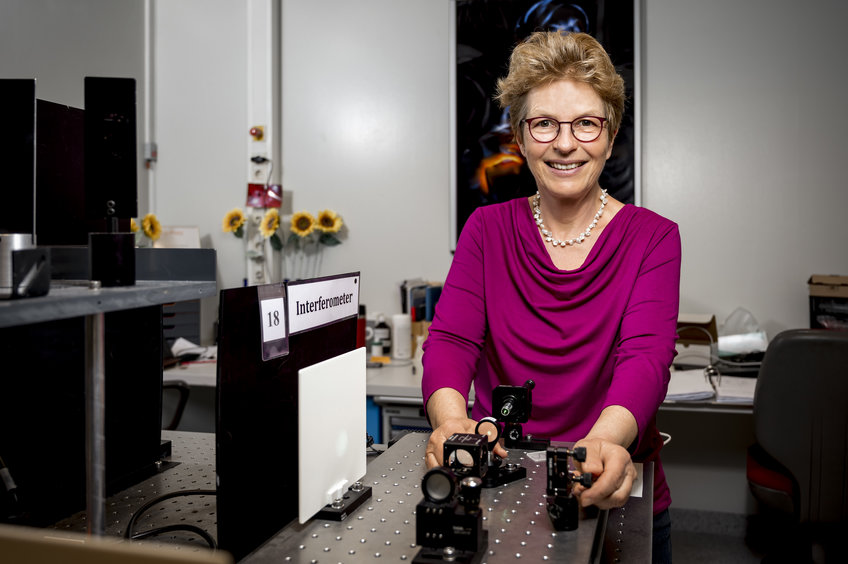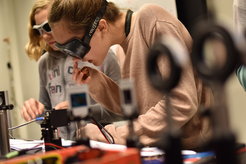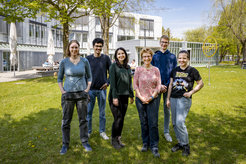
The PhotonLab’s source of energy
With great dedication and didactic skill, Silke Stähler-Schöpf conveys fascination for quantum optics to young people in the MPQ school laboratory.
The PhotonLab is the school laboratory at the Max Planck Institute of Quantum Optics. It is run by the physicist Dr Silke Stähler-Schöpf. Together with her team, she teaches pupils the basics of optics/photonics and quantum physics on 20 regularly changing experiment stations. Since visitor numbers cannot grow indefinitely, Stähler-Schöpf is developing new ideas on how the PhotonLab can reach even more young people with digital formats. The new approaches and surprising formats receive great recognition: in 2021, the PhotonLab received the LeLa award "Schülerlabor digital" from LernortLabor and in 2022 the LeLa award for the "Experiment of the Year".
Silke Stähler-Schöpf is proud of the PhotonLab. You notice that immediately when she leads visitors through her school lab. Her eyes sparkle and she enthusiastically presents the experiment stations. In passing, the head of the lab mentions other projects: an interactive book, the association of Munich school labs, regional competitions, Girls' Day, Catching Up to Corona, a quantum audio play. The list easily is a dozen long. Silke Stähler-Schöpf is involved in every one of the projects, and she initiated several of them herself. Stähler-Schöpf seems to be a real bundle of energy. Her energy benefits pupils and opens them the doors to the world of quantum physics.
The physicist with a doctorate began setting up the PhotonLab in 2011. The year before, Munich was awarded the Cluster of Excellence "Munich Centre for Advanced Photonics". With the funds, Prof. Ferenc Krausz, Director of the Attosecond Physics Department and part of the cluster, also ensured that the PhotonLab came to the MPQ. "In the beginning, I had a lab with nothing but technical material that had been left standing when an emeritus professor moved out," Stähler-Schöpf recalls: "It was roaring chaos."
Something like this, however, is not an obstacle for the maker. Nor was the fact that she initially had no idea how the femtosecond laser – a tool essential for attosecond physics – which she found in her new realm, actually worked. For what she brought with her, besides a seemingly irrepressible energy, was great experience in how to convey physics to young people. After completing her doctorate at the TU Munich, Stähler-Schöpf first took time off to raise her children. Later, she found her way back into the profession by learning about museum didactics and gave guided tours to young people at the Deutsches Museum on a freelance basis for many years. At that time, she called the demonstration experiments in the museum "button-pushing physics".
The fascination of experimentation

Do-it-yourself physics, on the other hand, was the goal of the PhotonLab from the very beginning. Stähler-Schöpf did as much research on the femtosecond laser as on various other devices that she purchased for the experiment stations in the school lab. The trick is not to have the most complicated technology possible. The experiments have to be suitable for teaching the pupils some of the basics of quantum optics, and they should be fascinating: "Like the experiment in which the young people were able to create plasma spheres with the femtosecond laser," says Silke Stähler-Schöpf: "The spheres glowed colourfully, were nice to look at and, along the way, it became clear what a plasma is."
Today, the femtosecond laser is no longer in the school laboratory. Instead, there are a total of more than 20 different stations with small, illustrative experiments of varying degrees of difficulty, from photonics to quantum physics. A popular classic is the experiment on the transmission of information via light. "The students have to precisely align a laser beam so that a loudspeaker plays music. In this way, the principle of the CD player or the transmission of information in the fibre optic cable becomes clear."
Thanks to the subject matter, the good pedagogical preparation and the appealing equipment, the PhotonLab quickly gained popularity. In the first year, about 250 pupils visited it, in 2019 already a good 2,000. Then came Corona, and kicked-off a rethinking process for Stähler-Schöpf. On the one hand, because a certain routine in the PhotonLab had set in, and on the other, because the number of visits could not be increased infinitely: "We can only reach a limited number of people with one school laboratory," says Stähler-Schöpf: "With digital offers, much more is possible.”
Interactive preparation for the visit to PhotonLab
This is how the idea for interactive books came about. They can be integrated into physics lessons and are thus a supplement to the usual teaching material. With the help of various formats – such as videos or podcasts – entire classes at school can familiarise themselves digitally with the experiments offered in the Photon Lab. Silent videos are particularly popular: They show the course of an experiment without sound. "The pupils are then supposed to speak the soundtrack to it," says Silke Stähler-Schöpf: "For that, they must already have understood the experiment well." In addition, there are research questions in the books that can be answered during real experiments on site. So the young people come to the PhotonLab well prepared and are motivated.
Such ideas are definitely worthy of a prize: the interactive book on the topic of the "Interferometer" was awarded the LeLa Prize "Schülerlabor digital" by LernortLabor in 2021. The next LeLa prize for 2022 is already lined up: This time for the "Experiment of the Year", which honours the quantum random number generator. It was developed by Linda Querini, a student trainee who worked at PhotonLab for many years and has now left for her doctorate at LMU Munich.
A funny world in Alice’s Quantum Land
The pipeline for further awards is likely to be full, because original ideas are always being created at PhotonLab. For example, the audio play "Alice in Quantum Land": some time ago, Stähler-Schöpf was faced with the challenge of having to explain the quantum world to small children at the "Forscha" trade fair. She had the idea of presenting a funny world to her listeners. A world in which one is not only small or large. You are small in one part, but big in another. You have blue and brown eyes at the same time, you are equally fat and thin. "I started to spin a story out of it. A colleague came along and said we should make an audio play out of it." No sooner said than done. In the team – especially in collaboration with colleague and trained narrator Veit Ziegelmeier – the plot was quickly found: Alice doesn't end up in Wonderland - but in Quantum Land - thanks to her escaped rabbit that has nibbled on the wrong mushroom.

Altogether the entire team: "The working students give me an incredible amount of energy," says Stähler-Schöpf: "They're all super motivated – it is simply contagious.” Stähler-Schöpf, a bundle of energy, also needs such a tailwind: "Normally I get my balance by cycling in nature," she says: "But some weeks are very packed. When I'm on the road at the weekend for physics competitions for which we prepare interested students, or on Saturdays for the student lab day, there's hardly any time left for leisure activities." That makes the good working atmosphere at PhotonLab all the more important.













